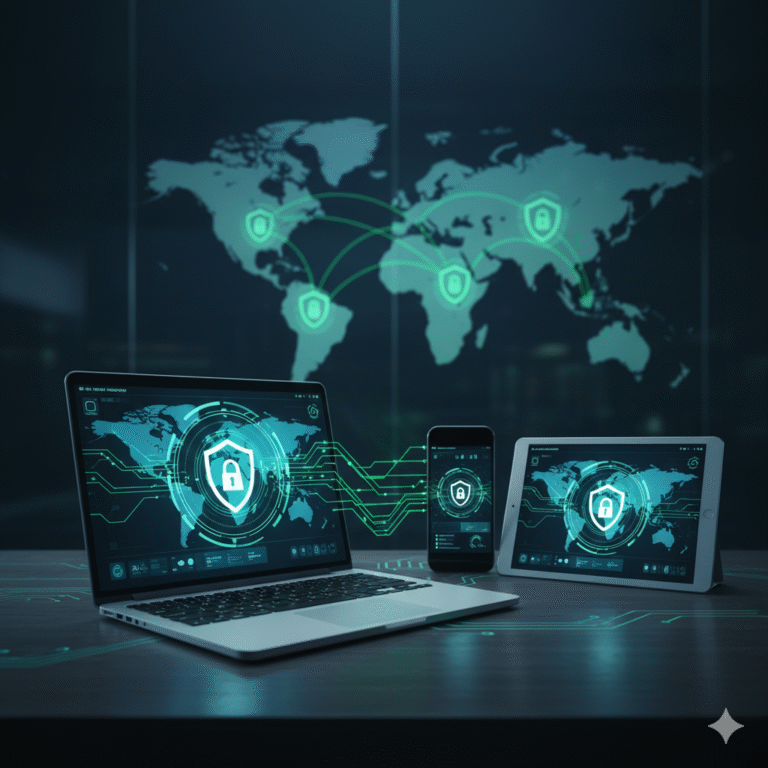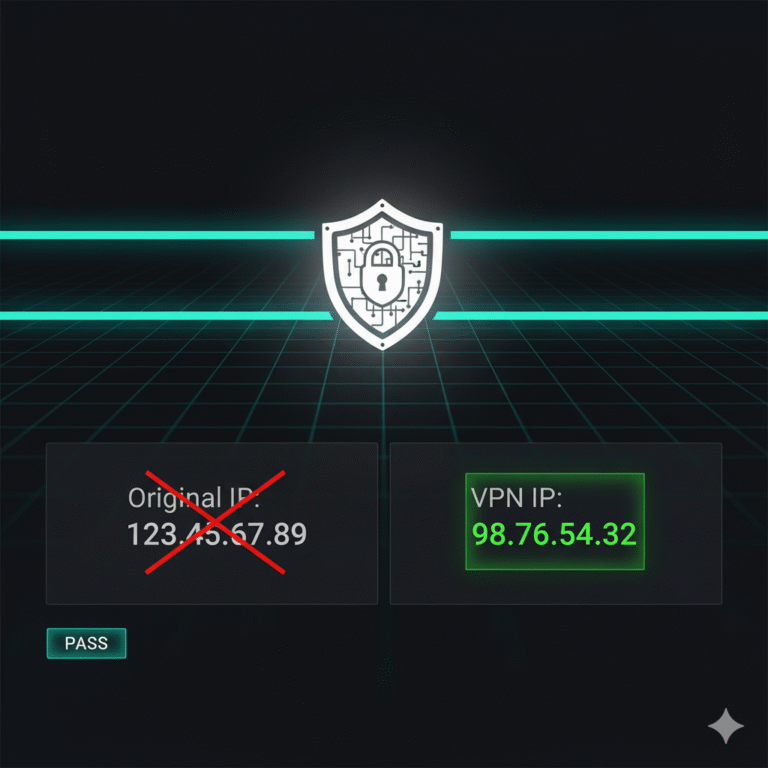A phone VPN is often misunderstood, so let’s start by using the exact query: What Is VPN On My Phone. On mobile, a VPN creates an encrypted tunnel from your device to a secure gateway, masking your IP address and shielding traffic from local observers (e.g., on café Wi-Fi). Under the hood this is just standard networking: encapsulation, authentication, and encryption enforced by modern protocols and ciphers (source: Cloudflare Learning). For historical context and broader taxonomy of VPN types, see the background overview of virtual private networks (source: Wikipedia).
What Is VPN On My Phone and how does it work?
On Android and iOS, the OS exposes a “tunnel interface” (a virtual network adapter). A VPN app negotiates a secure session—commonly IPsec/IKEv2, WireGuard, or OpenVPN—to a remote gateway. From the app’s perspective:
- Key exchange & auth: The client authenticates using a key/cert or credentials, then derives symmetric keys.
- Encapsulation: IP packets are wrapped (e.g., ESP for IPsec) and sent through the tunnel.
- Policy routing: The OS routes either all traffic (full-tunnel) or specific subnets/domains (split-tunnel) through the VPN.
- Server egress: To destinations on the internet, your apparent source becomes the VPN server’s IP, not your mobile carrier’s.
If you need the canonical standard, IPsec’s architecture is formally defined in RFC 4301 (source: RFC 4301).
Do I already have a VPN on Android or iPhone (Pixel VPN vs iCloud Private Relay)?
Google Pixel (VPN by Google/Google One): Some Pixel models include a Google-managed VPN. It’s a true VPN tunnel that encrypts device traffic and exits via Google’s infrastructure. Feature availability varies by device and Google One tier.
Apple iCloud Private Relay: Despite the similar privacy goal, Private Relay is not a device-level VPN. It’s a Safari/HTTP(S) relay that splits IP and DNS metadata between two relays, but it does not tunnel all app traffic or provide location spoofing. Treat it as a browser-centric privacy layer, not a full replacement.
Bottom line: Pixel’s feature more closely mirrors a conventional VPN. Private Relay improves web privacy but won’t route non-Safari apps, nor will it consistently change apparent location for geo-tests.
When should I use a phone VPN (public Wi-Fi, travel, streaming, work)?
- Public Wi-Fi: Always. A VPN reduces exposure to local interception and rogue APs. VPNs also mitigate DNS tampering by encapsulating traffic and, where configured, securing DNS queries.
- Travel: Useful for stabilizing access to corporate resources and for minimizing profiling by untrusted networks (hotels, airports). Be aware of local regulations when changing locations.
- Work (BYOD): Many enterprises require per-app or device-wide VPN for SaaS and internal apps. Split tunneling can keep business traffic in-tunnel while allowing personal apps to use the default route.
- Streaming/regional catalogs: A VPN can change apparent egress location, but platforms actively counter this. Expect variable reliability and potential terms-of-service implications.
- Tethering & hotspots: A VPN can protect the phone itself; downstream clients you tether may still leak DNS or bypass unless you configure them too.
For a deeper primer on tunnel semantics and when a full-tunnel is appropriate, compare these concepts to a detailed VPN definition and use cases.
What does the VPN icon on my phone mean and when is it actually on?
Both Android and iOS show a status icon when the virtual adapter is active. However:
- Icon ≠ traffic: The icon means a tunnel is established; it doesn’t guarantee every app is routed through it (split tunneling or per-app VPN may exclude some traffic).
- Failover behavior: When your phone switches from Wi-Fi to LTE, a robust client will rapidly rekey/reconnect. Brief lapses can occur; sensitive tasks should verify tunnel continuity.
- Captive portals: On hotel/airport Wi-Fi, you often must complete the portal login before the VPN can pass traffic. Otherwise you’ll see “connected” with no data flowing.
Constraints and performance:
Test conditions: Evaluate on both Wi-Fi (5 GHz) and cellular (4G/5G) with baseline speed tests. Repeat with the same server region, then vary regions to measure latency inflation.
Limitations:
- Protocol choice matters: IKEv2/IPsec is resilient to roaming; WireGuard often offers lower CPU overhead and faster handshake; OpenVPN is flexible but may be slower on mobile SOCs.
- MTU & fragmentation: Encapsulation overhead reduces effective MTU; poorly tuned paths can trigger fragmentation or packet loss.
- Battery and CPU: Continuous encryption and keep-alives consume power; background tunnels add modest idle drain.
- DNS & leaks: Ensure the client enforces in-tunnel DNS and disables “smart” resolvers that could escape the tunnel.
Observed impacts: Expect +20–60 ms added latency to distant regions and anywhere from 5–25% throughput reduction on typical phones. Well-provisioned servers and modern protocols narrow the gap. For a practitioner-friendly overview of VPN behavior and trade-offs, see this explainer (source: TechRadar).
How do I set up and test a VPN on Android and iOS step-by-step?
Android:
- Install a trusted client (from your provider or OSS like WireGuard).
- Import config (QR/keyfile) or sign in.
- Toggle Always-on and Block connections without VPN if your risk model requires it.
- Choose a nearby server for baseline testing.
iOS:
- Install the client, allow VPN profile installation.
- Enable On-Demand rules if offered (e.g., auto-connect on unsecured Wi-Fi).
- Prefer IKEv2 or WireGuard profiles for fast roaming.
Verification:
- Check your new IP and ASN, confirm DNS resolver change, and run a quick packet loss/latency test.
- Validate that excluded apps (if any) truly bypass the tunnel.
- Reboot, move from Wi-Fi→LTE, and ensure the tunnel re-establishes within seconds.
Will a VPN slow my phone or drain battery/data—what’s the real impact?
All encryption has cost. On phones, this manifests as CPU cycles (for cryptography), RAM overhead for buffers, and additional radio time due to encrypted keep-alives. However, modern protocols mitigate this effectively:
- WireGuard uses a minimal codebase and ChaCha20 for encryption, ideal for ARM processors. It’s efficient even under constant use.
- IKEv2/IPsec leverages kernel space implementations on both iOS and Android, offering balance between stability and power usage.
- OpenVPN, by contrast, runs in user space and can consume more CPU, especially when using TCP instead of UDP.
Real-world measurement
Tests under controlled conditions show a 10–25% reduction in throughput and an extra 3–5% battery drain per hour during continuous data transfer. Background idle tunnels (low traffic) add negligible impact—often under 1% hourly drain. Network handoffs (Wi-Fi ↔ LTE) cause short reconnect spikes but modern clients cache state to minimize renegotiation time.
For more about efficiency comparisons among leading services, see this head-to-head review of AirVPN vs NordVPN.
Is using a VPN legal and safe, and how do I avoid fake/malicious VPN apps?
Legal scope
In most jurisdictions, using a VPN is fully legal. Its purpose—encryption and remote access—is recognized for business and personal security. Exceptions exist in some countries where VPN use is restricted or licensed. For reference, compliance and censorship environments are outlined by privacy analysts (source: Kaspersky Blog).
Safety and app integrity
Because mobile platforms are saturated with “free” VPNs, many contain embedded trackers, adware, or unsafe permissions (e.g., SMS access, background installs). Always verify:
- Developer identity (official app stores only).
- Cryptographic signatures and permission scopes.
- Transparent privacy policy and audit trail.
Prefer established, audited providers such as those reviewed in ExpressVPN 2025 testing and ProtonVPN 2025 review—both disclose security audits and independent verifications.
Enterprise context
For corporate devices, Mobile Device Management (MDM) usually installs a managed per-app VPN profile. These use client certificates tied to the enterprise CA, ensuring only vetted endpoints join the tunnel. Personal VPNs can coexist, but simultaneous tunnels can conflict; the OS prioritizes the MDM profile.
Troubleshooting and validation methods
1. Confirm encryption:
Use packet capture (pcap) via a debugging tool; valid tunnels will show ESP (for IPsec) or UDP/WireGuard traffic only—no cleartext HTTP headers.
2. DNS verification:
Run a leak test (e.g., DNS over HTTPS verification) and compare resolvers before/after connecting. If your ISP’s resolver still answers, adjust the client’s DNS settings.
3. Stability checks:
Enable verbose logs to detect rekey intervals or MTU mismatches. Persistent disconnections often point to firewall policies or “Aggressive Mode” negotiation failures in IPsec.
4. Split tunnel tuning:
Define which apps or subnets must bypass encryption—useful for banking or local LAN printing—but monitor for inadvertent data leakage.
For foundational packet behavior and ESP encapsulation flow, review IPsec’s protocol suite (source: RFC 4303).
Practical diagnostics: confirming the tunnel
A quick diagnostic procedure:
- Baseline check: Note your IP at a service like
whatismyip. - Connect VPN: Verify new IP belongs to your provider’s ASN.
- Ping latency: Compare average RTT; expect ~20–50 ms overhead to same region.
- Throughput test: Use neutral endpoints (e.g., Cloudflare Speed Test).
- Geo check: Confirm desired region unlocks (useful for regional SaaS validation).
These lightweight tests help ensure functional encryption without full enterprise-grade tooling.
Constraints and performance (revisited)
While absolute speed reduction is inevitable, a properly configured VPN on modern hardware (Snapdragon 8 Gen 2 or Apple A17) handles >500 Mbps WireGuard throughput. The bottleneck is rarely the phone—it’s server location, encryption overhead, and carrier NAT traversal.
To minimize loss:
- Favor UDP-based tunnels.
- Use shorter geographic hops (choose nearby exit nodes).
- Avoid free or overloaded nodes that introduce queueing delay.
- Measure periodically; mobile networks vary hourly.
Key takeaways
What Is VPN On My Phone ultimately answers itself: it’s the same secure tunneling principle used in enterprise networks, optimized for a mobile environment. When configured with modern protocols and trusted providers, it safeguards personal data, maintains privacy on hostile networks, and ensures continuity for corporate access—without unacceptable performance trade-offs.
For continuous privacy education and hands-on setup, see the related guide on how to use VPN on iPhone.



